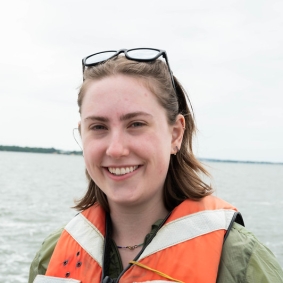Eight students will be presenting the summer work at the Ocean Sciences Meeting in March 2022!
Grace Guinan, University of Virginia
Class Year:
2023Mentor:
Dong Liang, Ph.D. Michael Gonsior, Ph.D.Project Title:
New Applications of Machine Learning in Analytical ChemistryAbstract:
Dissolved Organic Matter (DOM) is a dynamic carbon pool with largely unknown molecular composition. We are focused on the subset of DOM that fluoresces (FDOM) and can be linked to overall DOM molecular signatures derived from ultrahigh resolution mass spectrometry (HRMS). Complex HRMS and fluorescence data were collected from samples at Bermuda Atlantic Time-series Station (BATS) and Hawaii Ocean Time-series (station ALOHA). Using sparse orthogonal factor regression (SOFAR), a method previously used in genetic analysis, we aim to learn underlying association networks between the HRMS and fluorescence datasets (Uematsu et al. 2019). Increasing sparsity in a large dataset minimizes noise and promotes selection of the most significant latent factors. On the other hand, orthogonality ensures independence. SOFAR applies these two concepts to select smaller sets of predictor m/z ions while increasing independence of the fluorescence response variable. This project is one example of a growing collaboration between big data and environmental sciences that showcases the powerful role of machine learning techniques across disciplines, from genetics to analytical chemistry.
Location:
Chesapeake Biological LaboratoryPublications:
Gonsior, M., M. Lahm, L. Powers, F. Chen, S. Leigh McCallister, D. Liang, G. Guinan* and P Schmitt-Kopplin. 2024. Optical properties and molecular differences in dissolved organic matter at the Bermuda Atlantic and Hawai'i ALOHA time-series stations. Environmental Science: Advances.
Presentations:
Guinan, G.*, D. Liang, M. Gonsior, L. Powers, M. Lahm, and P. Schmitt-Kopplin. 2024. New applications of machine learning in marine biogeochemistry. Ocean Sciences Meeting, New Orleans, LA.




